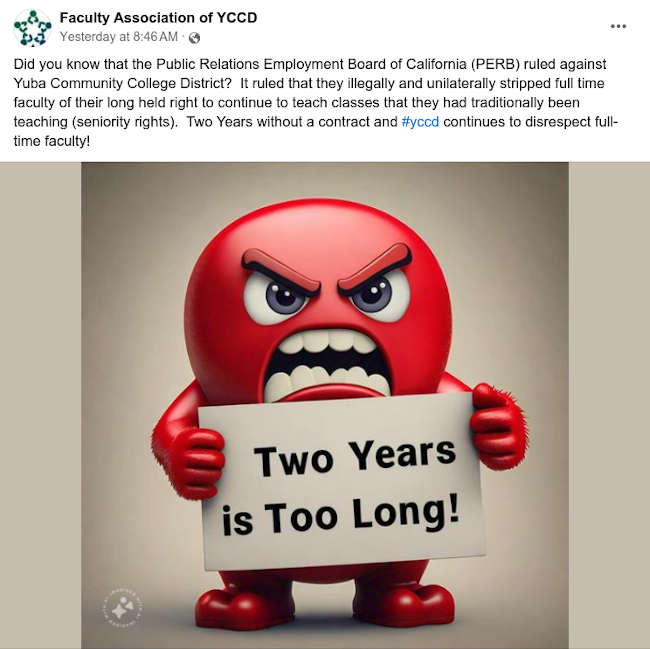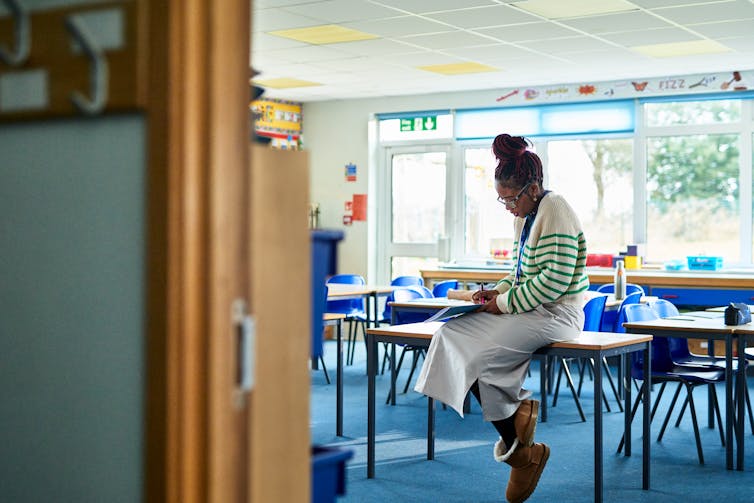LAKE COUNTY, Calif. — A state administrative law judge has ruled that the Yuba Community College District violated labor law and workers’ rights in its negotiations with district faculty, a decision the chancellor said the district will appeal.
The Public Employment Relations Board, or PERB, handed down the decision in July that the Yuba Community College District violated the Educational Employment Relations Act by eliminating the right of first refusal.
By doing so, the district changed the procedure for assigning classes to full-time faculty without affording the Faculty Association of the Yuba Community College District adequate notice and opportunity to bargain the decision or effects of the change.
The district was ordered to take several corrective actions that include ceasing its existing procedures for course assignments and interfering with the association’s representation rights; within 30 days of the ruling, the district is ordered to rescind its Sept. 1, 2022, elimination of the right of first refusal and reinstate the previous procedures; bargain in good faith with the association over the relevant articles of the collective bargaining agreement; and compensate the association and affected employees for any losses incurred as a result of the violations, with interest.
“This ruling is a resounding affirmation of the importance of collective bargaining and the protections it affords workers,” Travis Smith, the president for the Faculty Association, said in a Monday statement. “We are committed to ensuring that our members' rights are respected and upheld. The district’s actions not only disrupted the professional lives of our members but undermined the collaborative spirit that is essential for the success of our educational community.”
PERB found that, in addition to violating EERA and changing the procedure for assigning classes to full-time faculty without proper negotiation with the association, the district also violated other subdivisions of EERA by interfering with the association’s right to represent bargaining unit employees and the employees’ right to representation.
However, while the Faculty Association has maintained this is a significant victory, the district has announced that it will appeal.
On Sunday, the Faculty Association posted about its frustration with the district on Facebook.
“Did you know that the Public Relations Employment Board of California (PERB) ruled against Yuba Community College District? It ruled that they illegally and unilaterally stripped full time faculty of their long held right to continue to teach classes that they had traditionally been teaching (seniority rights). Two Years without a contract and #yccd continues to disrespect full-time faculty!” the announcement said.
Emails union leadership circulated to staff said the district has continued to challenge the contract currently in place with staff that both sides have agreed to for more than 30 years.
 Deep disagreements between district, faculty association
Deep disagreements between district, faculty association In an email that circulated to district staff on July 22 — the same day district leadership received PERB’s proposed decision, Chancellor Dr. Shouan Pan announced the ruling.
“The Proposed Decision indicates that YCCD cannot unilaterally decide on this matter and has a duty to provide the Association adequate notice and opportunity to bargain before eliminating the Right of First Refusal. The District is disappointed in the ALJ's [administrative law judge’s] Proposed Decision and is consulting with legal counsel to consider its options including an appeal which must be filed within 20-days, or the Proposed Decision becomes final,” Pan wrote.
Pan said the district board and leadership “recognize, value, and honor the work of both the full-time and part-time faculty. The faculty, along with classified professionals and managers, are essential members of the YCCD community, and we must work together to achieve our shared goal of increasing student success and meeting the needs of our community.”
On Aug. 14, Pan followed up by announcing to district employees that an appeal was under way.
“After thorough conversations with legal counsel, the Governing Board, and Chancellor’s Cabinet, we have decided to respond to the Proposed Decision by requesting additional time and filing an appeal. Our position is that the Right of First Refusal, while initially well-intentioned, hampers our institution’s ability to fulfill its mission of providing high-quality, affordable higher education that meets the needs of all individuals in our diverse communities. The higher education landscape has changed dramatically since this practice was instituted 20 some years ago. To meet current and evolving student demands, YCCD requires the flexibility to offer courses in various modalities, shorter term lengths, and during evenings and weekends,” Pan wrote.
He emphasized that the decision to appeal “should not be perceived as a confrontation with our full-time faculty. Full-time faculty are integral to the YCCD team, which includes trustees, administrators, part-time faculty, and classified professionals. By working together, we can enhance student success and serve our community more effectively.”
Pan added, “We hope our request for additional time will facilitate a ‘reset’ in our good faith negotiations, allowing us to find a win-win solution that benefits both full-time faculty and YCCD. Our collective goal is to create an educational environment where our students can thrive.”
That same day, Dr. Annette Lee, professor of management and business at the Woodland Community College Lake County Campus in Clearlake, wrote to Pan and the Board of Trustees to tell them she was perplexed at Pan’s email.
Lee said nothing about the right of first refusal, or ROFR, prevents Yuba Community College District “from fulfilling its mission of providing high-quality, affordable higher education that meets the needs of all individuals in our diverse communities. Quite the contrary; YCCD has all of the flexibility it needs to offer courses in various modalities, shorter term lengths, and during evenings and weekends without disrupting full-time faculty's ROFR. As a former scheduling dean, I know this to be true. In light of this, your statement about full-time faculty being integral to the YCCD team feels disingenuous, and to be honest, a bit like gaslighting.”
She said she wondered if the senior administration and negotiating team truly understand the scheduling process and how it relates to the Faculty Association contract.
“I am shaking my head and hoping someone can help me understand what is happening right now between YCCD and full-time faculty. Though I know labor issues are as old as time, I've never personally seen anything like this,” Lee wrote.
Lee’s email also noted that district faculty have gone from well-compensated to some of the lowest paid community college faculty members in the state, while also dealing with increased health insurance premiums, course caps raised by 25 to 35%, “and no reasonable movement toward a fair contract in well over two years.”
She added, “I have to wonder if you, Chancellor Pan, and the Board of Trustees really understand how damaging this all is to faculty. I have been working for almost 4 decades and have never in my life felt so abused, disrespected, and undervalued by an employer. It's soul-crushing and I'm just not sure where to go from here.”
Chancellor: District not prioritizing part-time staffOn Thursday, Lake County News reached out to Pan to ask about his comments about needing more flexibility in negotiations, if that had been quantified in financial terms, what would happen if the appeal isn’t granted — such as leading to staff and service cuts — and the belief by personnel that part-time staff have been prioritized over full-time staff.
Pan responded the same day to say that he could not answer those questions due to the negotiations and because “things are so fluid,” adding, “We do not want to negotiate through emails or public media.”
He added, “I can tell you this, unequivocally: The conjecture about the district prioritizing PT faculty over the FT faculty or eliminating the FT faculty is totally wrong and baseless. We depend on both faculty groups and our staff to serve district mission. This kind of rumor is irresponsible and dangerous. The negotiations with the full-time faculty union have gone on too long. My team and are determined to work with the labor partner to find a settlement that is acceptable to both sides and to ensuring that the District can sustain itself for the long term.”
In its Monday statement, the Faculty Association — which noted that its members have been working under an expired contract for two years — maintained that the PERB ruling unequivocally supports its position that the district’s actions “were a direct violation of the rights of our faculty and undermined the collective bargaining process.”
The Faculty Association said those seniority rights are a critical component of the faculty’s ability to secure fair, consistent assignments and to ensure the most experienced and qualified professors are entrusted to teach classes.
The district’s unilateral decision to remove this right was unjust, unlawful, and according to Kevin Ferns, the association’s lead negotiator, “The district’s unilateral action was an underhanded attempt to take away rights that both sides had agreed upon for the past 30+ years. We are hopeful this decision will compel the District to come back to the table and negotiate with us in good faith. Two years, too long.”
An email from Ferns sent to staff on July 22 said they began negotiating the 2022-2025 contract in March 2022, and after two and a half years of negotiations had only reached tentative agreement on just four of 12 articles with the district. At that time, the last meeting between faculty and the district had occurred on May 24, and they said the district had not responded to requests to return to the negotiating table.
Ferns said in that email that it has asked for staff pay to be raised to meet rising inflation. “Over the past three years, the District has received a 15.85% raise from the state in the form of a Cost of Living Adjustment, or COLA allocation, which means the District is receiving more than $12 million per year of additional monies due to inflation that that it could pass along to its employees. The District has done this for its administrators, classified staff, and part time faculty over the past year, and we are happy that the District recognizes the hard work being done for our students by those bargaining units and is providing them with salary enhancements to keep up with record inflation. We believe the District should be treating full time faculty with the same respect and dignity it has afforded to all the other employees throughout the District.”
In the faculty association’s Monday statement, the union suggested that its one step forward with the PERB decision was met with two steps back from district leadership’s decision to appeal the ruling, announced in Pan’s email.
“Unfortunately, the district seems intent on continuing to spend hundreds of thousands of dollars in taxpayer resources on lawyers to pursue their meritless legal arguments dragging out contract negotiations and whittling-away at morale. It’s a real shame,” said Smith.
“The Faculty Association remains steadfast in its dedication to advocating for the rights of our members and ensuring that the District honors its legal obligations. We look forward to working constructively with the District to implement this ruling, negotiate a fair contract, and prevent future violations of our collective bargaining rights,” the statement said.
Email Elizabeth Larson at elarson@lakeconews.com. Follow her on Twitter, @ERLarson, or Lake County News, @LakeCoNews.

![]()

 How to resolve AdBlock issue?
How to resolve AdBlock issue? 










